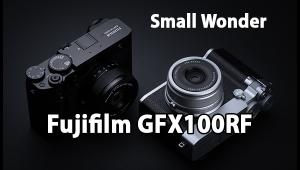Olympus OM-D Mirrorless Camera Review
The Olympus OM-D is a retro-style camera that harkens back to the OM System of the 1970s and 1980s. In the current Olympus lineup, this Micro Four Thirds system camera sits somewhere between the PEN cameras and the E-System cameras. Like the PEN, it offers a very compact design and many helpful features for beginners, yet the design is oriented toward a classic SLR.



The OM-D uses an electronic viewfinder instead of an optical finder; the new electronic finder has a very high resolution and shows a very brilliant and crisp image, as evidenced by the ease of manual focus viewing.
The small body fits perfectly even in large hands, is well balanced, and allows for fast and intuitive set up of all parameters. Two dials on the top allow the user to change image parameters very quickly, although the cursor field on the back is very small and because of the tiny size can sometimes cause faulty operation and missed settings.
In addition to standard exposure modes the camera offers many additional features like scene modes and art filters, which can be used to gain special effects such as “dramatic tone” or “pop art.” One quite unique feature is called “Live Bulb.” When taking pictures in Bulb mode it is able to present an updated live preview on the screen. The photographer can stop the image recording by pressing the shutter release button again when the desired brightness or light intensity is reached in the image on the screen.


Olympus declares the AF system of the OM-D as the fastest AF system of all system cameras. During our test the automatic AF system worked extremely fast and—even more importantly—without any errors like “focus pumping” and fruitless searches for focus. We were so impressed that we hope to see similar AF systems in other digital cameras. The speed of the AF system is comparable with a mid-level SLR camera with standard phase detection AF sensors.
Image Quality
Color: The color reproduction is excellent. The camera showed extremely good results in the GretagMacbeth chart. The automatic white balance system worked nearly perfectly under all lighting conditions/color temperatures. Only the very bright gray pattern of the test charts shows a slight shift into the green and yellow direction, while the other gray patterns are located exactly in the center of the graph. Skin tones are reproduced very naturally. Only saturation is a little lower than in images taken with other cameras. Most people would like to see a bit more saturated colors, but nearly all nuances look very natural.

Sharpness: The camera showed a good result in our resolution test. The limiting element seems to be the new kit lens (12-50mm), which causes some color aberrations that soften the contours of contrast lines. To compensate for this effect the camera uses a visible sharpness filter effect which causes some “overshot” and “clipping” effects in our test images. In combination with this lens, the OM-D reproduced the ISO 12,233 chart with 2685 of 3456 lines in picture height. Real-life images are reproduced with a very low soft touch, which can be noticed in the standard test box shot and the portrait shot.

Noise: The camera offers very clean and smooth images even when taking pictures with settings up to ISO 3200. In images taken with ISO 6400 the color noise filtering, which normally causes a very subtle smooth effect, will cause color clouds in homogeneous areas. The luminance noise keeps on a low level up to ISO 3200 and the y-factor will exceed 1.0 percent only in images taken with ISO 6400 and higher. Even images taken with ISO 12,800 are still usable and show a lot of crisp details; only images taken with ISO 25,600 show an annoying amount of color noise or anti-noise filtering effects.

Scorecard
Pro
• Very compact but robust body
• Sealed body (to protect the camera from dust and humidity)
• Very nice ELV, large OLED screen on the back
• Interesting additional features like “Live Bulb” function
• Fast AF system
Con
• Very small cursor field (reduces handling comfort)
• Swivel monitor not totally articulated (can only be flipped up- and downward)
Image Tech
Image Tech is where we publish web-exclusive lab reports on cameras. To read the reports please go to the Shutterbug homepage at www.shutterbug.com and click on the Image Tech tab on the top navigation bar. New reports are published frequently, so check Image Tech for updates.
The Olympus OM-D with the 12-50mm kit lens has a list price of $1299. For more information and further tech specs, visit: www.olympusamerica.com.
Lab results and test images by BetterNet, our TIPA-affiliated testing lab. Edited by George Schaub.
- Log in or register to post comments

















































